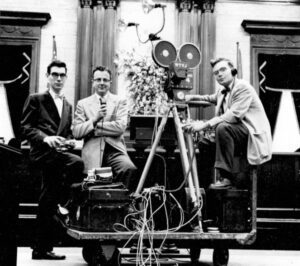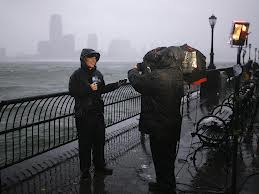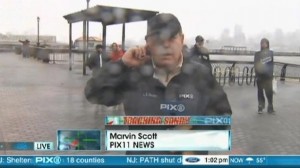Coverage of Hurricane Sandy by local New York City broadcast television stations comes as a refreshing change from the usual high giggle factor and uninspiring pabulum-like content purveyed on a daily basis. But it took a multi-billion-dollar-in-damage hurricane to reveal what was always there.
But first, some background.
Ever since media entrepreneur Ted Turner inaugurated Cable News Network (CNN) in June of 1980, local broadcast news stations have gotten the message: television news is cheaper to produce than a variety show or other forms of entertainment programming. This is not to say producing television news is bargain-basement, it isn’t, but it is an historic fact that both on a local and national programming level, broadcast television operations, staffs, and, in the case of national news programs, bureaus have shrunk dramatically. Stringers (freelancers) are a way of life on many local broadcast news programs. Moreover, in the small to medium-sized broadcast television markets it is a fact of life that television news directors short of reportage assets rely on video content supplied by corporations and associations purveying products or services–resulting in biased, un-objective reporting—that come in the guise of a public service announcement, i.e., a PSA.
 Technology has also changed the face of broadcast television news (as well as cable produced news). In the olden days—when news was shot on film—it took a crew of four or five, plus the reporter to shoot a news segment. Then the raw news material had to be edited. Today, it’s possible (as in the case of local cable news channel NY/News 1) for the reporter, camera-person, and editor to be one person. Digital-based cameras are very lightweight and memory is cheap. If there is a crew, it’s one person behind the camera, one person in front. Distance is not a problem given the television trucks with satellite remote capability. Today, television reporters must know about reportage and the technology to produce and new segment. Talk about crunching costs!
Technology has also changed the face of broadcast television news (as well as cable produced news). In the olden days—when news was shot on film—it took a crew of four or five, plus the reporter to shoot a news segment. Then the raw news material had to be edited. Today, it’s possible (as in the case of local cable news channel NY/News 1) for the reporter, camera-person, and editor to be one person. Digital-based cameras are very lightweight and memory is cheap. If there is a crew, it’s one person behind the camera, one person in front. Distance is not a problem given the television trucks with satellite remote capability. Today, television reporters must know about reportage and the technology to produce and new segment. Talk about crunching costs!
The advent of digital television technology has provided another opportunity: a move away from a once or twice a day local news programming, to local news programming in many day-parts: very early morning, mid-morning, midday, late afternoon, early evening, and late evening. While this programming schedule has created jobs for numerous junior local television news reporters, it has also evolved a programming tone that borders on the sophomoric. I call it the giggle factor.
 The giggle factor can be expressed in terms of how many times reporters (especially in the early morning shows) bring their own opinions and commentary into the news stories. And it doesn’t matter the combination of the anchors’ gender or how seasoned the anchors are. What seems to matter is everyone presents a “happy face” regardless of the content of the news. It’s as if the anchors are sitting in your living room subjectively chatting about the news, rather than objectively reporting the news. Is this the effect of Facebook, Twitter, and other so-called social media where the tone of communication has meandered down to the level of two gossips talking over a fence?
The giggle factor can be expressed in terms of how many times reporters (especially in the early morning shows) bring their own opinions and commentary into the news stories. And it doesn’t matter the combination of the anchors’ gender or how seasoned the anchors are. What seems to matter is everyone presents a “happy face” regardless of the content of the news. It’s as if the anchors are sitting in your living room subjectively chatting about the news, rather than objectively reporting the news. Is this the effect of Facebook, Twitter, and other so-called social media where the tone of communication has meandered down to the level of two gossips talking over a fence?
It also needs to be said, however, that local broadcast news is a technological opportunity for the good of community waiting to happen. One of the major advantages of contemporary television technology is that it can present news with great immediacy. For example, when the first plane hit the North Tower of the World Trade Center already positioned television cameras gave viewers a looksee almost immediately—within minutes. And while we were watching, everyone witnessed the second plane hit the South Tower.
Television technology is now almost everywhere: on helicopters, police cars, elevators, buildings, telephone poles, traffic light structures, helmets, et al. Cameras are now so small, they fit into the palm of one’s hand. Material can be conveyed to a central location for further broadcast in moments. Today, even non-professional reporters are providing footage via I-phones and other mobile devices.
The technological immediacy factor aside, the “message” of television is that it conveys the emotional factor of the news with visceral effect. What you see is what you get. It touches you in the gut.
![]() One more comment about technology: as of this writing, only about 76 people lost their lives to Sandy’s wrath in the entire New York Tri-State area. Why? Because of computer and electronic technologies. Weather forecasters in the United States and Europe using a panoply of computer models predicted Hurricane Sandy’s unprecedented left turn in the Atlantic putting America’s Northeast coastline in its path. There were many who thought all the brouhaha of last week—the warnings of evacuations in New York City’s Zone A, for example—was just governmental over-caution and a lot of media hype. Turns out it wasn’t—not even close. If there had been no warnings, no evacuations, no preparations and precautions, the human cost would have been much, much worse.
One more comment about technology: as of this writing, only about 76 people lost their lives to Sandy’s wrath in the entire New York Tri-State area. Why? Because of computer and electronic technologies. Weather forecasters in the United States and Europe using a panoply of computer models predicted Hurricane Sandy’s unprecedented left turn in the Atlantic putting America’s Northeast coastline in its path. There were many who thought all the brouhaha of last week—the warnings of evacuations in New York City’s Zone A, for example—was just governmental over-caution and a lot of media hype. Turns out it wasn’t—not even close. If there had been no warnings, no evacuations, no preparations and precautions, the human cost would have been much, much worse.
Hurricane Sandy will go down as one of the worst and costliest natural disasters of the last hundred years at least. For New York City (I am a long-time New York City resident), this is our Katrina. If the center of the storm had made landfall a mere 50-75 miles further north, I’m not sure if much of New York City would even be in a position to begin to recover a few days after the worst was over. Fortunately for New York City, and unfortunately for Atlantic City and much of the New Jersey coastline, Sandy hit where it did.
 With all this as prelude, and the experts at The Weather Channel notwithstanding, the story behind the story is the work of the local broadcast channel reporters and their counterpart meteorological experts. If you spent any time watching the local news (presuming you had power), it was observable that many of the reporters in the field went to great lengths to report what was going on in neighborhood after neighborhood, community after community. And the time they spent in the field was no few hours at a time. Some reporters stuck with it for 18 or more hours at a time, before, during, and after the storm had passed.
With all this as prelude, and the experts at The Weather Channel notwithstanding, the story behind the story is the work of the local broadcast channel reporters and their counterpart meteorological experts. If you spent any time watching the local news (presuming you had power), it was observable that many of the reporters in the field went to great lengths to report what was going on in neighborhood after neighborhood, community after community. And the time they spent in the field was no few hours at a time. Some reporters stuck with it for 18 or more hours at a time, before, during, and after the storm had passed.
Hurricane Sandy changed the tone of local news reporting 180 degrees, at least for now, perhaps for a time longer. This was an instance of a perfect storm combination of technology and reportage. Even with 9/11 still in our memories, the coverage of Hurricane Sandy by local broadcast channels, at least in this observer’s eyes, brought out the best in what local, community-oriented news reporting is supposed to be about. Gone were the giggles and the superficial banter. Gone were the trivial stories, or the over-reported stories of little consequence. Hurricane Sandy provided that opportunity for local broadcast television channels in the New York metropolitan area to show their stuff beyond the technological gee-whiz. It has been an opportunity for a show of reportage professionalism and humanity.
The question is: will it take another instance of great import for the high level, serious reporting to show itself? Or once this crisis is over—a moment in time perhaps weeks, months, or even years in the future—will the giggle factor return to lull viewers into a state of silliness?
Please write to me at meiienterprises@aol.com if you have any comments on this or any other of my blogs.
Eugene Marlow, Ph.D.
November 5, 2012
© Eugene Marlow 2012


